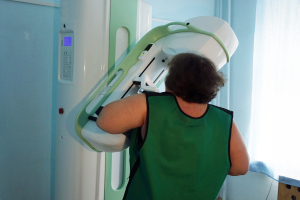por
John R. Fischer, Senior Reporter | February 02, 2021

A new proposal calls for ending mammography in breast cancer survivors over 75 with a life expectancy of less than five years
A new set of proposed guidelines have stirred up debates about the pros and cons of screening elderly breast cancer survivors.
The guidelines were developed by a nationwide panel of experts who recommend discontinuing routine mammograms for survivors, aged 75 or older, with a life expectancy under five years and to stop screening those with a 5-10-year life expectancy. They do, however, say mammography should continue for patients with a life expectancy greater than 10 years.
"The standard recommendation for mammography in breast cancer survivors of all ages has been annual screening. There has been little guidance on how to tailor screening for older survivors — what role life expectancy, risk of recurrence, patient preferences, or the trade-offs associated with mammography should play," said Dr. Rachel Freedman, of Dana-Farber Cancer Institute and the first author of the new paper, in a statement. "The result is that the use of mammography for older survivors has been highly inconsistent.”




Ad Statistics
Times Displayed: 45314
Times Visited: 1410 Keep biomedical devices ready to go, so care teams can be ready to care for patients. GE HealthCare’s ReadySee™ helps overcome frustrations due to lack of network and device visibility, manual troubleshooting, and downtime.
Freedman and her colleagues assert that the lengthy time required to show the small benefits of the mammography and the persistent negative effects of mammography make it of little help to breast cancer survivors with a life expectancy under five years, even for those with a history of higher-risk tumors. In addition, ceasing mammography should be considered when life expectancy is five to 10 years and continue annually or biennially when it is beyond 10 years. Women, aged 85 or older, should also not be subjugated to mammography, as their life expectancy is often under five years, unless they are in extraordinary health and have a strong preference for continued testing, according to the guidelines.
Feedback from an 18-member panel of patients was used to develop the guidelines. The authors also recruited breast cancer primary care, geriatrics, radiology, survivorship and nursing experts from across the U.S. to review scientific literature on the risk of in-breast cancer among older breast cancer survivors, evaluating the subtype of cancer, treatments, the age of patients and health status. A parallel review of research on the advantages and disadvantages of mammography was conducted as well.
The literature review showed that low risk for breast cancer in either breast among most older survivors, particularly those treated with hormone-blocking therapy for hormone receptor-positive tumors. The panel estimated the risk for survivors developing breast cancer over a 10-year-period and organized the risk based on cancer type and treatment. The review of mammography research found that mammography offers little to modest clinical benefit for many older women. The main downsides were false-positives, due to the detection of growths that appear malignant but are not; anxiety associated with diagnostic testing; and overtreatment.
“With the number of older women who will be diagnosed with breast cancer expected to increase in the coming years, it's important that we find ways to individualize decisions for each patient's circumstances and preferences,” said Freedman.
The panel combined the findings of both reviews to form their guidelines, which were then studied and revised several times by a group of clinicians, patient advocates and by five clinician focus groups. The International Society for Geriatric Oncology gave a final review, after which the guidelines were refined and finalized.
The findings were published in
JAMA Oncology.

